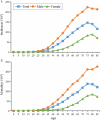Temporal trends of incidence, mortality, and survival of liver cancer during 2011-2020 in Fujian Province, Southeast China
- PMID: 39633411
- PMCID: PMC11616380
- DOI: 10.1186/s13690-024-01462-7
Temporal trends of incidence, mortality, and survival of liver cancer during 2011-2020 in Fujian Province, Southeast China
Abstract
Background: Liver cancer is a common malignant tumor of the digestive system. We aimed to estimate the trend in the burden of liver cancer in Fujian Province, China, during 2011-2020.
Methods: The population-based cancer data was collected from the cancer registry in Fujian Province during 2011-2020. Segi's world standard population was used to calculate the age-standardized incidence rates and age-standardized mortality rates. The temporal trend of liver cancer was displayed by annual percentage change and average annual percentage change (AAPC). Relative survival of liver cancer was calculated as the ratio of observed survival to expected survival. The age-standardized relative survival was calculated according to the International Cancer Survival Standards 1.
Results: There were 14,725 patients diagnosed with liver cancer and 12,698 patients died between 2011 and 2020. For males, there was a downward trend in incidence and mortality (AAPC: -3.86%, -3.44%). Similarly, the downward trend was also shown in females (AAPC: -3.96%, -2.79%). The highest age-specific incidence and mortality were in the 75-79 age group (146.59/100,000 and 137.99/100,000, respectively), and there was no downward trend in this group during the period. The overall age-standardized 5-year relative survival was 10.77% in 2011-2015 and 14.54% in 2016-2020. During the study period, the percentage improvement of survival was higher in males than in females (34.75% and 25.33%). The percentage improvement of survival in urban was higher than that in rural (38.64% and 28.75%). Except for the age group over 75, the survival of patients in other age groups all has improved.
Conclusions: Liver cancer remains a serious public health problem in Fujian Province, China, which needs to be solved, especially in some high-risk groups such as the elderly, high-risk males, and rural populations. Early detection and treatment is the key to the prevention and treatment of liver cancer.
Keywords: Incidence; Live cancer; Mortality; Survival; Trend.
© 2024. The Author(s).
Conflict of interest statement
Declarations. Ethics approval and consent to participate: The Ethics Committee of Fujian Cancer Hospital determined that ethics approval and informed consent were not required for this research, because this was a retrospective study that used source data that were completely unidentifiable, and all data were anonymous. Consent for publication: Not applicable. Competing interests: The authors declare no competing interests.
Figures




Similar articles
-
Incidence and mortality of lung cancer in 2018 and the temporal trends from 2010 to 2018 in Henan province, China: a population-based registry study.Ann Transl Med. 2022 Sep;10(18):1005. doi: 10.21037/atm-22-4029. Ann Transl Med. 2022. PMID: 36267711 Free PMC article.
-
[The spatio-temporal trend of female breast cancer incidence and mortality in Shandong Province from 2012 to 2023 and trend prediction].Zhonghua Liu Xing Bing Xue Za Zhi. 2025 Apr 10;46(4):646-654. doi: 10.3760/cma.j.cn112338-20240830-00539. Zhonghua Liu Xing Bing Xue Za Zhi. 2025. PMID: 40274571 Chinese.
-
[Cancer burden in Hebei Province from 2011 to 2020].Zhonghua Zhong Liu Za Zhi. 2025 Apr 23;47(4):316-321. doi: 10.3760/cma.j.cn112152-20240110-00017. Zhonghua Zhong Liu Za Zhi. 2025. PMID: 40268548 Chinese.
-
Time-trend of the incidence and mortality of esophageal cancer from 2010 to 2018 and its statistics in 2018 in Henan, China.Ann Transl Med. 2022 Aug;10(16):899. doi: 10.21037/atm-22-4027. Ann Transl Med. 2022. PMID: 36111000 Free PMC article.
-
Incidence and mortality of gastric cancer in 2018 and their trends from 2010 to 2018 in Henan Province, China: results from a provincial population-based cancer registry.Ann Transl Med. 2022 Sep;10(18):1012. doi: 10.21037/atm-22-4100. Ann Transl Med. 2022. PMID: 36267737 Free PMC article.
References
-
- Devarbhavi H, Asrani SK, Arab JP, Nartey YA, Pose E, Kamath PS. Global burden of liver disease: 2023 update. J Hepatol. 2023;79(2):516–37. 10.1016/j.jhep.2023.03.017. - PubMed
-
- Bray F, Laversanne M, Sung H, Ferlay J, Siegel R, Soerjomataram I, et al. Global cancer statistics 2022: GLOBOCAN estimates of incidence and mortality worldwide for 36 cancers in 185 countries. CA Cancer J Clin. 2024;74(3):229–63. 10.3322/caac.21834. - PubMed
LinkOut - more resources
Full Text Sources

